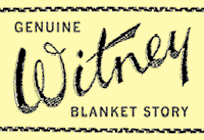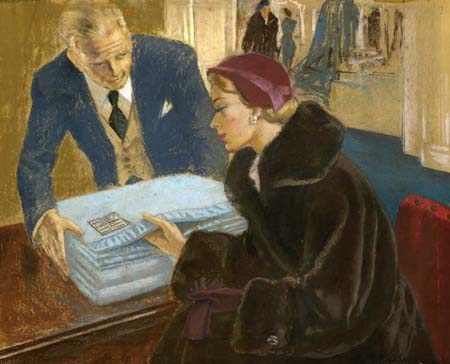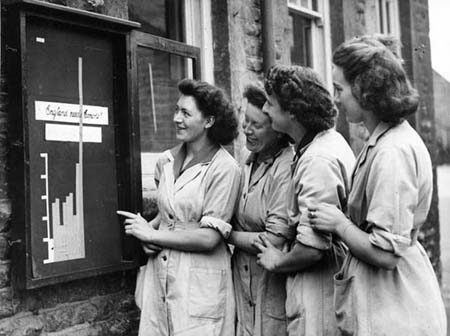

Who bought the blankets?
 Design for a 1950s advertising campaign for Early's, showing a woman in a shop inspecting an 'Earlywarm' blanket. The idea was not new: raw wool was being exported from the Cotswolds to Flanders from at least the 12th century onwards. By the 15th century regular wool shipments were sailing from English ports to Northern Europe, and Italian merchants visited the Cotswolds to buy up wool stocks. Exporting cloth and blankets was a logical extension of this trade. Witney also lay within easy reach of London, through which most goods bound for export passed. Witney was supplying blankets to North America from as early as the 1670s [1], where they were highly prized by fur trappers and many Native American peoples living in the cold climate. A barter trade was established whereby the Native Americans exchanged beaver pelts, which were in great demand in Europe for making hats and clothing, for blankets and other goods. They valued the blankets for bedding but chiefly as warm, hardwearing clothing that took less preparation to wear than fur. Blankets also held greater significance than purely trade items for some Native American peoples: they were given as gifts on important occasions, offered as a marks of respect and sometimes denoted the status or rank of certain individuals.  Early's advertising sign from the 1950s showing a Chinese person, a Fiji Islander and a Native American as customers of 'Earlywarm' blankets. Trade between Witney and Africa also seems to have been established early. There is a record of a petition presented to the House of Lords in 1694 by Witney cloth makers on behalf of the Royal African Company, complaining that threats to the Company's monopoly were damaging the local trade. Arthur Young, who was an agricultural and industrial commentator, recorded in his 1768 book 'A Six Weeks' Tour through the Southern Counties' that the best and most expensive Witney blankets went to Spain and Portugal, with cheaper products destined for North America. By the end of Queen Victoria's reign foreign markets were still expanding and Smith's and Early's had achieved an international reputation; between them they were receiving orders from the United States, Bermuda, Australia, Newfoundland, South Africa and South America amongst other places [4]. War, conflict and natural disasters often resulted in an increased demand. Blankets from Witney were certainly supplied to Wellington's expeditionary armies during the Napoleonic Wars at the beginning of the 19th century. Cabin blankets chiefly for use at sea had also been made in Witney since around 1713 [5]. In 1908 an earthquake in Sicily created a sudden need for blankets and staff at Early's Newland factory worked many extra night shifts to meet the demand. To keep the workers going at this time, sausages, mashed potatoes and coffee were prepared next door at Newland House [6].  Four women Witney blanket workers looking at a chart titled 'England Needs Exports' showing recent blanket production; probably dating from just after the Second World War. Just before the war in 1939, Early's advertising claimed that their exports had grown five times since the previous year and highlighted their diverse range of foreign customers, who included Native Americans, Fiji Islanders and the Chinese. For the Chinese market a particular sort of scarlet blanket with a border of ten black stripes and green whipping (to conform to religious custom) were produced; these were often given as wedding gifts. Hotels, hospitals, airlines, shipping lines and holiday camp companies were all significant consumers of Witney blankets in the latter half of the 20th century. The demand for blankets from small bedding shops and numerous independent department stores was gradually being taken over by larger chains and supermarkets such as Marks and Spencer, Tesco's and Debenham's at this time.  Front page of a Great Universal Stores home shopping catalogue of the 1930s, which featured Early's blankets. The introduction of Fiberweaving in the 1960s changed the blanket market. Previously, good quality Witney blankets were a long-term household investment, but blankets could now be made relatively cheaply and were produced in more colours and patterns. This created a new market where blankets were bought to match fashionable decorative schemes and might be changed or thrown out relatively quickly.
|
|
| References [1] Plot 1677: pp278-280 [2] Plummer and Early 1969: p39-42 [3] Plummer 1934: p101 [4] Townley 2004: p93 [5] Plummer 1934: p62 [6] Plummer and Early 1969: p104 [7] Plummer and Early 1969: p125 [8] Townley 2004: p99 |
Listen: Download audio file Doreen Foggett, who worked in the finishing room at Marriott's from 1955 -1959, describes the popularity of mail order catalogues after the Second World War (122Kb). |
